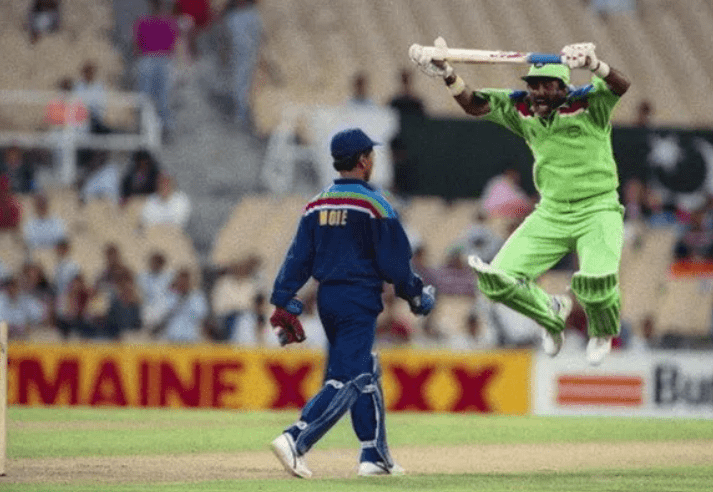
Cricket, often hailed as a gentleman’s game, has witnessed its fair share of intense rivalries and historic contests. Yet, none come close to the fiery spectacle that is the India vs Pakistan cricket rivalry. Beyond the boundaries and bat-and-ball, this rivalry is a colossal clash of emotions, politics, and cricketing prowess that has left an indelible mark on the sport. Join us on a thrilling journey through history as we explore how the India vs. Pakistan rivalry has not only captivated hearts but also transformed the very essence of cricket.
1. The Genesis of a Rivalry
The genesis of the India vs Pakistan cricket rivalry is deeply intertwined with the political and historical context of the Indian subcontinent in the mid-20th century. The story begins with the partition of British India in 1947 into two independent nations: India and Pakistan. This partition was driven by religious and political factors, with India becoming a secular state and Pakistan emerging as an Islamic nation. Amid the upheaval and the immense human suffering that accompanied the partition, cricket, a beloved sport on the subcontinent, took on new significance.
The inaugural cricket match between India and Pakistan, often referred to as the “First Test”, was played from October 16 to 18, 1952, at the Feroz Shah Kotla Ground in Delhi. This historic Test marked the formal commencement of cricketing rivalry between the two nations. The atmosphere surrounding this match was electric, with fans and players alike feeling the weight of history and the sense of national identity riding on their performance.
The rivalry was further fueled by the fact that many players from the undivided Indian cricket team, which had achieved international success before partition, found themselves representing India or Pakistan. This led to intriguing subplots, with former teammates and friends pitted against each other in cricketing battles of immense significance.
Example:
One of the early stars of Pakistan cricket, Fazal Mahmood, had previously played for India. In the inaugural Test match, he showcased his skills by taking 12 wickets in the match and played a pivotal role in Pakistan’s victory. His performance not only marked Pakistan’s arrival on the international cricket scene but also added to the drama and intrigue of the rivalry.
The First Test was just the beginning. Over the years, the India vs Pakistan cricket rivalry evolved from a mere sporting contest into a reflection of national pride and identity. The matches between these two nations became more than just cricket; they were symbolic representations of the complex relationship between India and Pakistan. The passion, excitement, and historical significance associated with each encounter have made this rivalry one of the most iconic and enduring in the world of sports.
2. The Thrilling Cricket Duels
The India vs. Pakistan cricket rivalry has been the stage for some of the most thrilling and memorable cricket matches in history. These encounters have not only been about runs and wickets but have also been a showcase of courage, determination, and the ability to handle immense pressure.
One of the defining characteristics of matches between India and Pakistan is their unpredictability. Whether in Test matches, One Day Internationals (ODIs), or T20s, these contests have often defied expectations, producing results that have sent shockwaves through the cricketing world.
The thrilling duels between India and Pakistan have given rise to iconic moments that are etched in the collective memory of cricket enthusiasts:
- Miandad’s Last-Ball Six (1986): Perhaps the most legendary moment in the rivalry’s history, Javed Miandad’s last-ball six off Chetan Sharma during the Austral-Asia Cup final in Sharjah is still talked about decades later. The audacious stroke not only secured Pakistan’s victory but also added another chapter to the rivalry’s folklore.
- Tendulkar’s Desert Storm (1998): In the 1998 Coca-Cola Cup held in Sharjah, Sachin Tendulkar played two extraordinary innings against Pakistan, batting India to victory in both matches. His unbeaten 143 and 134 in successive games against a potent Pakistani bowling attack demonstrated his genius and ability to single-handedly turn the tide in India’s favor.
- The 2007 ICC World Twenty20 Bowl-Out: During the inaugural ICC World Twenty20, the group stage match between India and Pakistan ended in a tie. Instead of a Super Over, a bowl-out was conducted to determine the winner. India managed to hit the stumps more times than Pakistan, securing a thrilling and somewhat unconventional victory.
These are just a few examples of the countless dramatic moments that have unfolded in India vs. Pakistan encounters. The intense rivalry brings out the best in players, often elevating them to performances that define their careers and resonate with cricket fans worldwide.
These thrilling cricket duels have not only provided unforgettable moments but have also showcased the competitive spirit of both nations. Matches between India and Pakistan are more than just cricket; they are emotionally charged contests that reflect the pride and passion of two cricket-crazy nations. The anticipation and excitement surrounding each fixture continue to make them unmissable events on the global cricketing calendar.
3. Beyond Cricket: Geopolitical Undercurrents
The India vs. Pakistan cricket rivalry is a multi-dimensional phenomenon that extends far beyond the boundaries of the cricket pitch. It is a reflection of the complex geopolitical relationship between the two nations and serves as a microcosm of the political and diplomatic undercurrents that have defined their history since gaining independence in 1947.
A Symbol of Bilateral Relations:
Cricket matches between India and Pakistan often take on greater significance than just sporting contests. They are viewed as barometers of the state of bilateral relations between the two nations. The ebb and flow of these relations can have a direct impact on whether or not cricketing ties are maintained.
Example 1: The 1965 and 1971 Wars:
The 1965 and 1971 wars between India and Pakistan led to the suspension of cricketing ties. In both instances, the heightened tensions between the two nations spilled over into the cricketing arena. The 1965 war resulted in the cancellation of a scheduled Test series, while the 1971 war led to a significant hiatus in cricketing relations.
Cricket as a Diplomatic Tool:
Cricket has, at times, been used as a diplomatic tool by both nations to improve relations or ease political tensions. High-profile bilateral series have been scheduled with the hope of fostering goodwill and promoting peaceful coexistence.
Example 2: The 2004 India-Pakistan Series:
In 2004, after a prolonged period of political and diplomatic tension, India and Pakistan agreed to resume cricketing ties with a historic tour. This series, comprising both Test matches and ODIs, was seen as a significant step towards improving bilateral relations. It demonstrated how cricket could be employed as a bridge between the two nations, temporarily putting aside political differences in favor of a shared love for the sport.
The Impact of Terrorist Incidents:
Unfortunately, terrorist incidents and border conflicts have, on occasion, disrupted cricketing ties between India and Pakistan. These incidents have led to the suspension of matches and have further complicated the relationship between the two cricketing rivals.
Example 3: The 2008 Mumbai Attacks:
The 2008 Mumbai attacks, which were carried out by terrorists with alleged links to Pakistan, had a profound impact on the India vs. Pakistan cricket rivalry. India suspended all cricketing ties with Pakistan in the aftermath of the attacks, leading to a hiatus in bilateral cricket that lasted for several years.
Cricket as a Platform for Diplomacy:
Conversely, cricket has also served as a platform for diplomatic meetings and gestures of goodwill between the two nations. During major cricket tournaments, such as the ICC events, diplomatic officials from India and Pakistan have occasionally used the opportunity to engage in diplomatic dialogue.
Example 4: The 2011 ICC Cricket World Cup Semi-Final:
The 2011 ICC Cricket World Cup semi-final between India and Pakistan, held at Mohali, witnessed a historic moment when then-Pakistani Prime Minister Yousaf Raza Gillani and then-Indian Prime Minister Manmohan Singh met to watch the match together. While the meeting did not lead to any major breakthroughs in bilateral relations, it symbolized the potential for cricket to act as a diplomatic conduit.
The India vs. Pakistan cricket rivalry is not only about the sport itself but also about the complex geopolitical dynamics that have shaped the relationship between these two nations. Cricket serves as a mirror reflecting the highs and lows, the tensions, and the moments of détente in their long-standing history. It is a reminder of the power of sport to transcend political differences, albeit temporarily, and unite people across borders in the shared joy of competition and camaraderie.
4. A Global Phenomenon
The India vs. Pakistan cricket rivalry isn’t confined to the Indian subcontinent; it has transcended geographical boundaries to become a global sporting phenomenon. The fervor, excitement, and anticipation surrounding these clashes extend far beyond the shores of India and Pakistan, making it one of the most-watched and talked-about rivalries in international sports.
Television Viewership and Broadcast Rights:
Matches between India and Pakistan consistently rank among the most-watched sporting events globally. Cricket enthusiasts around the world tune in to witness the spectacle, resulting in astronomical television viewership figures. You can tune in to YouTube or official broadcasters’ websites or apps for india vs pakistan live streaming.
Example 1: 2019 ICC Cricket World Cup Match:
During the 2019 ICC Cricket World Cup, the group stage match between India and Pakistan garnered an estimated television audience of over one billion viewers. This staggering viewership figure reflects the match’s status as a global sporting event that captivates audiences from diverse backgrounds.
Cricketing Diaspora:
The global reach of the India vs. Pakistan rivalry can be attributed in part to the presence of cricketing diasporas from both nations. Large communities of Indian and Pakistani expatriates and immigrants reside in various parts of the world, ensuring that the rivalry’s fervor extends to far-flung corners of the globe.
Example 2: The United Kingdom:
In the United Kingdom, home to a significant South Asian population, India vs. Pakistan matches have a massive following. Matches at venues like Lord’s in London witness a sea of blue and green, as fans from both nations come together to support their teams.
Global Fan Engagement:
Social media platforms and digital media have further amplified the global reach of the rivalry. Fans from different countries engage in passionate discussions, share memes, and participate in online debates, contributing to the worldwide buzz surrounding these encounters.
Example 3: Social Media Trends:
On social media platforms like Twitter and Facebook, hashtags related to India vs. Pakistan matches trend worldwide. Fans from various countries, including those with no direct connection to either nation, join the conversation, adding to the rivalry’s global allure.
Cultural Significance:
The India vs. Pakistan cricket rivalry has transcended sport to become a cultural event. Non-cricketing audiences are drawn to the matches because of the emotional and historical dimensions associated with the contest.
Example 4: The Film Industry:
The rivalry’s cultural significance is evident in the entertainment industry. Bollywood and Lollywood, the Indian and Pakistani film industries respectively, have produced movies that incorporate the cricket rivalry’s backdrop, further cementing its importance in the cultural psyche of the subcontinent and beyond.
Support for Cricket Overall:
The global attention generated by the rivalry has also contributed to the growth of cricket as a sport. It has piqued the interest of individuals who may not have previously followed cricket, drawing them into the world of bat and ball.
The India vs. Pakistan cricket rivalry is not merely a regional affair; it is a global phenomenon that captivates the imagination of cricket enthusiasts worldwide. The immense television viewership, the passionate engagement of cricketing diasporas, the power of social media, and the rivalry’s cultural significance have all combined to make it a fixture on the international sporting calendar. It serves as a testament to the universality of sport and its ability to unite people from diverse backgrounds in the celebration of competition and camaraderie.
5. Cricketing Legacy and Inspiration
The India vs. Pakistan cricket rivalry isn’t just about the contests on the field; it’s about the profound impact it has had on the sport itself, leaving an enduring legacy and serving as an unending source of inspiration for cricketers and fans alike.
Forging Heroes in the Crucible:
These high-stakes clashes have been the crucible in which cricketing heroes are forged. It’s where players transcend their abilities and become legends. These aren’t just matches; they are epic sagas where the underdog can rise to glory and the favorite can crumble under the weight of expectations.
Example 1: Miandad’s 6 and the Birth of a Legend:
Javed Miandad’s audacious last-ball six in 1986 isn’t just a moment frozen in time; it’s an embodiment of courage and conviction. It’s an inspiration to generations of cricketers who dream of seizing the moment, regardless of the odds.
Example 2: Tendulkar’s Desert Storm – A Testament to Genius:
Sachin Tendulkar’s “Desert Storm” innings in 1998 isn’t just about runs on the board; it’s about the mastery of a craft and the ability to dominate even in the most challenging conditions. It’s a beacon for aspiring cricketers, a reminder that excellence knows no bounds.
Fostering Fearless Cricket:
The rivalry has nurtured a brand of cricket that’s fearless, electric, and packed with drama. Players learn to thrive under pressure, to cherish the spotlight, and to embrace the challenge of going head-to-head with their fiercest rivals.
Example 3: Virat Kohli – The Modern Maestro:
Virat Kohli, the current torchbearer of Indian cricket, has often spoken about how his early experiences in India vs. Pakistan matches shaped his approach to the game. His unwavering commitment, passion, and ability to thrive in high-pressure situations are a direct product of the rivalry’s crucible.
Example 4: Babar Azam – A Rising Star:
Babar Azam, Pakistan’s batting sensation, has also drawn inspiration from the rivalry. His elegant stroke play and consistency in pressure situations are reminiscent of the greats who have graced these contests before him.
Unleashing Passion and Pride:
The India vs. Pakistan rivalry taps into the deepest reservoirs of passion and pride. It’s a reminder that cricket isn’t just a game; it’s a celebration of identity and a showcase of resilience.
Example 5: The 2011 World Cup Semifinal – A Test of Nerves:
The 2011 ICC Cricket World Cup semifinal between India and Pakistan was a test of nerves, where the desire to win for one’s nation outweighed personal glory. It’s a reminder that in the face of immense pressure, the heart of a champion beats with a love for their country.
In the end, the India vs. Pakistan cricket rivalry is more than a series of matches; it’s a living legend, an ever-evolving story of triumph, heartbreak, and inspiration. It has given us cricketing titans and unforgettable moments, but it has also given us a lesson – that in cricket and in life, the greatest achievements are often born from the crucible of rivalry, and the most enduring legacies are etched with the spirit of determination and unwavering passion.
By: John Fernandes



